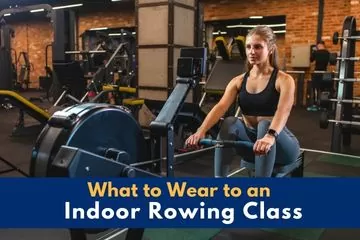
Hi everyone. It’s Petra, and if you’re new to indoor rowing, you might be a bit nervous wondering what to wear.
Don’t worry. Everyone feels that way at first.
Want to come across as an old hand? Would you like to be able to focus on the class and not on your uncomfortable choice of clothes?
Keep reading! I’ll tell you everything you need to know so you can walk into your first indoor rowing class with confidence and finish without a single blister.
- Need a Laugh: See Our Rowers Pick UP Lines!
How Should I Dress for an Indoor Rowing Class?
If you’ve used rowing machines as a part of your workout, then you are already ahead of the game.
For those of you who haven’t, you might wonder what would be appropriate to wear.
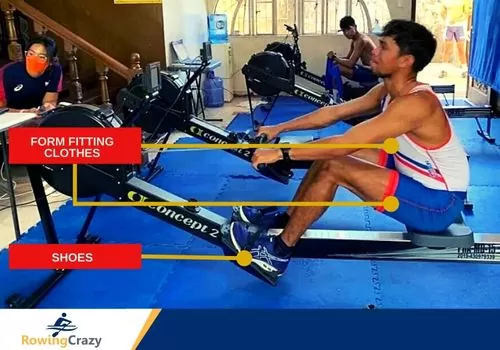
After all, rowing isn’t as common as Zumba or yoga classes. You can actually find clothing that says “Zumba wear” or “yoga pants” right on them.
What to wear to a rowing class isn’t as hard as you might think.
Think synthetic and smooth. You wouldn’t dream of wearing loose fitting bell-bottomed pants to a spin class because the clothing might get caught in the bike, right? The same is true with rowing.
First, choose synthetic materials. You want something that will wick away moisture and dries quickly. Next, choose smooth and form-fitting clothing.
This doesn’t mean skin tight—you need to be able to move vigorously and not let your clothing get in the way.
Consider some yoga pants with skinny legs. If they stop just above the ankle, that would be perfect.
The same is true with your shirt. A form-fitting short-sleeved or tank top will work just fine.
Ladies, wear a sports bra. It doesn’t have to be super tight since your girls won’t be doing too much bouncing, but you’ll want to avoid having the girls “hang” in front of you or move too much while you are rocking back and forth.
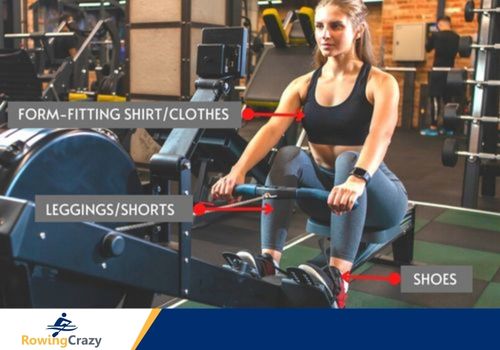
Underwear is a personal preference here. I’ve known friends who thought commando was the only way to avoid butt blisters. Other friends went with boy-short style that covered most of the booty, and still others who wore hipsters or even granny panties because it covered their butt.
Avoid thongs or loose-fitting underwear. I would suggest that you start with hipsters or another style that covers your bottom. After a few classes, you can adjust as needed.
Oh yes, avoid cotton underwear. It gets wet easily and doesn’t dry, which could lead to chafing.
Gentlemen, while you don’t need to concern yourself with a sports bra, think twice about your choice of underwear. Boxers probably won’t work as they are loose-fitting. Consider wearing some of the longer boxer briefs that go to about mid-thigh.
Guys should also wear form-fitting shorts, such as bike shorts or even men’s yoga pants, as long as they aren’t bell bottoms or boot-cut style.
Smooth fitting and synthetic, if you follow those two words when choosing clothing, you’ll do just fine.
What Should I Bring to a Rowing Class?
One of the great things about an erg (which is what the machines are frequently called ) is that you don’t really need any special equipment. No special shoes, socks, or anything else, except perhaps some gloves, which I will talk about shortly.
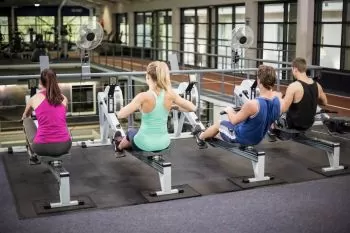
You should tie your hair back or wear a sweatband on your head if you tend to sweat from your face a lot. Your hands will be occupied so you won’t be able to wipe the sweat away unless you stop rowing.
Take off any necklaces or rings to avoid injury. Wear some lightweight shoes, such as cross trainers.
Bring a gym bag to store your clothes, keys, and other items. You may end up putting it in a locker, so bring your own combination lock as well.
Last, bring a water bottle. Be sure that you eat something about 30 minutes before class. A granola bar, a piece of fruit, or something light.
How to Avoid Blisters
While a rowing machine is a low-impact piece of equipment, that doesn’t mean it can’t hurt you.
Rowing requires you to use your hands in ways that you probably aren’t used to. Unless your job involves manual labor or tasks, like a carpenter, gardener, or construction worker, your hands can easily get blisters from holding and pulling on the handle.
You can take the wait-and-see approach if you like (wait and see if you develop blisters on your hands), or you can be proactive.
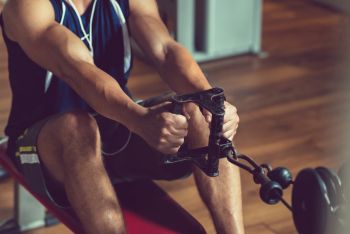
Let me be the first to tell you that out of a class of 50 people, probably 40 of them will develop blisters unless they used gloves.
Personally, I would rather just wear gloves and avoid blisters altogether.
You can buy some of the special rowing gloves or just use some weight-lifting gloves. You are basically looking for gloves that are form-fitting, with a padded hand but have cutouts for the fingers.
Yes, you can also get butt blisters, but those are usually more of a problem for those sitting in a rowboat than sitting on an erg.
If you want to know more about butt blisters and how to avoid them (or what to do if you get them), you might want to check out this article.
Avoiding injury is always a good thing, and a rowing workout may make you sore, but injuries aren’t as common.
What to Expect in Class
If you’ve never used a rowing machine before, hopefully, the instructor will go over the proper rowing form.
If possible, tell the instructor before class starts that you’ve never rowed before and you’ve heard that form is important. Hopefully, they will give you a little bit of personal instruction first.
You might also want to watch a few videos before your class about how to row properly so you have at least some idea of what you should be doing.
When signing up for your first class, find out if there’s an opportunity to choose a beginner’s class—you should definitely go with that. The rowing workouts might seem slow, but it’s really important that you learn proper form before you learn speed.
An indoor rowing class usually has rowing machines lined up like a classroom. The instructor or leader will face the class and give you guided directions.
You should do a few minutes of warm-up and cool-down each time you start an indoor class.
The type of workout you do will depend on the type of class you signed up for and whatever goals the instructor has.
Don’t be surprised if the instructor has you get off the machine and do some floor exercises, such as squats, or if they tell you to stop using your legs and just use your arms or just your legs.
While indoor rowing classes do work the entire body, some instructors like to mix things up and do some off-the-rower exercises.
Follow the instructor’s lead and you should have a total body workout that will leave you breathless.
Are Rowing Classes Worth It?
You bet your booty they are!
While spin classes get a lot of attention, the fact is that these workouts and other workouts, such as treadmills and spin bikes, only work the lower body.
Most indoor rowing classes last 30-60 minutes. You’ll get a total body workout in that time.
Imagine, no more “leg days” or “ab workouts”! You will work 86 percent of the muscles in the body with every rowing workout.
You will find that most people row 3- 4 days a week and then do some cross-training the other days. Remember to give your body one full day of rest each week.
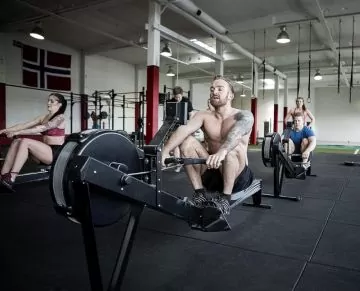
Indoor rowing means that you can get in a full workout in less time.
If you want to lose weight, nothing burns more calories than using a rowing machine except for jumping rope. Of course, you will probably need to take indoor rowing classes 5 days a week to burn that stubborn belly fat, but if you are only looking for cardio and strength training or to maintain your current weight, 3-4 rowing workouts a week is really all you need.
Get all the benefits of cardio exercise in less time by taking up indoor rowing.
If you want to get those benefits without going to the gym, you can enjoy the same workout at home when you buy your own rowing machine.
Not sure where to start? Check out this article for more information about indoor rowing machines.
Improve your current fitness level no matter what it is, lose weight, maintain a healthy weight, and protect your joints simply by doing rowing workouts.
It certainly doesn’t get much easier than that!
Will I Be Sore After a Class?
Depending on your current fitness level, it’s common to feel a bit sore after your first indoor rowing class.
Even if you still feel sore after two or three classes, don’t worry about it. Make sure that you have very little or no more soreness before you take another class.
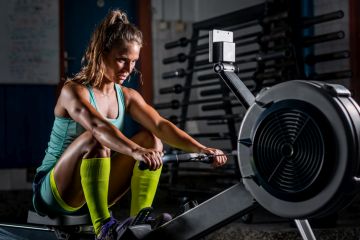
Trying to complete a rowing workout while you still have sore muscle groups is a sure way to hurt yourself.
Give yourself plenty of time to rest between classes. If you are still feeling sore, skip the class and try doing some gentle stretching and walking.
You should recover fairly quickly. As your body becomes more accustomed to the work you are asking it to do in this sport, the soreness and achy muscles will go away soon.
The Bottom Line
Indoor rowing classes are fun and exciting. Your heart rate will increase, you’ll probably sweat in places you never thought possible, but at the end of the class, you’ll want to sign up for another one.
Practice makes perfect, so be sure that you understand how to do the strokes properly, and more than anything else, have fun!
There are lots of videos online about proper form, how to adjust resistance levels on certain machines, and more information about how to buy the perfect rowing machine for your own home gym.
I hope you found this information helpful. If you did, please feel free to pass it along to your friends, family, or others who you think might find it interesting.
Stay happy and healthy, friends, and enjoy your first indoor rowing class!
Written by Petra Amara – RowingCrazy.com
CEO & Founder of RowingCrazy, National Rower, Coxswain Womens Eight Team, Rowing Coach & Writer
Petra is a Mother of two and owner of Rowingcrazy.com. Petra lives and breathes rowing, she also has a passion for writing which lead her to start RowingCrazy.com to share her rowing experience and expertise with others.





